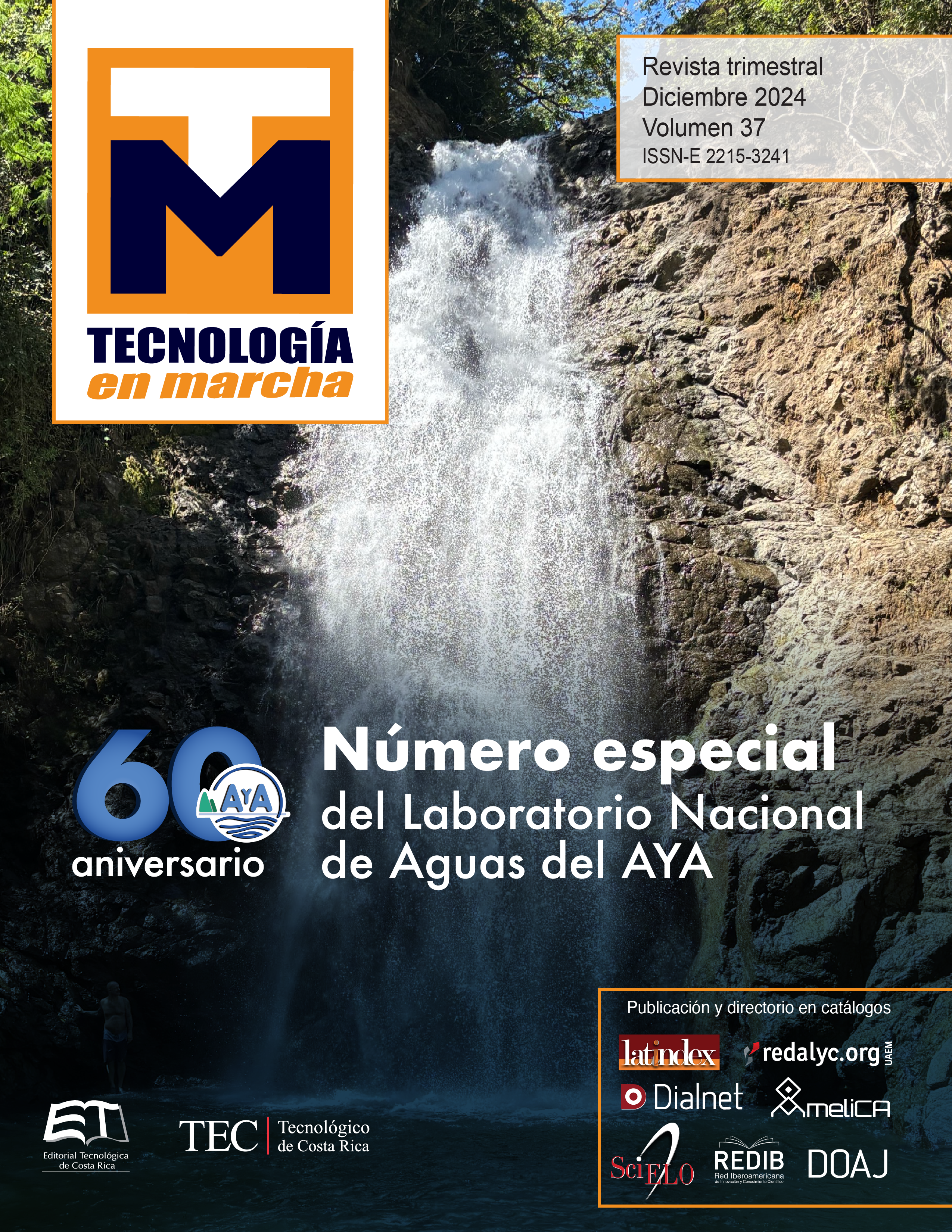Helminth eggs: A validation for their determination and quantification in Water, Wastewater and Sludge of Costa Rica
Main Article Content
Abstract
The presence of helminth eggs in water represents a public and environmental health problem, which can affect a large number of the population. Given the lack of an updated and validated methodology and the lack of indication in Costa Rican regulations, a methodology is proposed for the identification of helminth eggs in water, wastewater and sludge. The validation of the technique was carried out by evaluating nine performance parameters such as: Limits of Detection, Limits of Quantification, Repeatability, Reproducibility, Specificity, Selectivity, Sensitivity, Uncertainty and Veracity. Samples of each of the matrices were analyzed by inoculating 50% of them with helminth eggs from a certified reference material. The established methodologies were optimized through sample sedimentation and centrifugation processes to obtain an acceptable recovery. The results obtained from the validation were in accordance with the reference methodologies and with what is required for compliance with national legislation by establishing an appropriate methodology for the identification and quantification of helminth eggs.
Article Details

This work is licensed under a Creative Commons Attribution-NonCommercial-NoDerivatives 4.0 International License.
Los autores conservan los derechos de autor y ceden a la revista el derecho de la primera publicación y pueda editarlo, reproducirlo, distribuirlo, exhibirlo y comunicarlo en el país y en el extranjero mediante medios impresos y electrónicos. Asimismo, asumen el compromiso sobre cualquier litigio o reclamación relacionada con derechos de propiedad intelectual, exonerando de responsabilidad a la Editorial Tecnológica de Costa Rica. Además, se establece que los autores pueden realizar otros acuerdos contractuales independientes y adicionales para la distribución no exclusiva de la versión del artículo publicado en esta revista (p. ej., incluirlo en un repositorio institucional o publicarlo en un libro) siempre que indiquen claramente que el trabajo se publicó por primera vez en esta revista.
References
Jiménez, B., Maya, C., Sánchez, E., Romero, A., Lira, L., & Barrios, J. A. (2002). Comparison of the quantity and quality of the microbiological content of sludge in countries with low and high content of pathogens. Water Science and Technology, 46(10), 17–24. https://doi.org/10.2166/wst.2002.0278
Campos, M. C., Beltrán, M., Fuentes, N., & Moreno, G. (2018). Huevos de helmintos como indicadores de contaminación de origen fecal en aguas de riego agrícola, biosólidos, suelos y pastos. Biomedica, 38(1), 42- 53. https://doi.org/10.7705/biomedica.v38i0.3352
Jiménez, B. (2007). Helminth ova removal from wastewater for agriculture and aquaculture reuse. Water Science and Technology, 55(1–2), 485–493. https://doi.org/10.2166/wst.2007.046
Maya, C., Pérez, M., Velásquez, G., Barrios, J. A., Román, A., & Jiménez, B. (2019). Quick incubation process to determine inactivation of Ascaris and Toxocara eggs. Water Science and Technology, 80(12), 2328–2337. https://doi.org/10.2166/wst.2020.062
Jimenez-Cisneros, B. E. (2009). Helminth Ova Control in Wastewater and Sludge fos Agriculture Reuse. Water and Health, 2(Encyclopedia of Life Support Systems (EOLSS)).
Murillo, J., & Peinador, M. (2000). Enteroparásitos : Detección y Vigilancia en Aguas Residuales.
MINAE. (2007). Reglamento de Vertido y Reuso de Aguas Residuales. 56.
MINAE. (2015). Reglamento para el Manejo y Disposición Final de Lodos y Biosólidos. La Gaceta Diario Oficial.
Robles, I., Becerra, E., Barrios, J. A., Maya, C., Jiménez, B., Rodríguez-Valadez, F. J., Rivera, F., García-Espinoza, J. D., & Godínez, L. A. (2020). Inactivation of helminth eggs in an electro-Fenton reactor: Towards full electrochemical disinfection of human waste using activated carbon. Chemosphere, 250, 1–10. https://doi.org/10.1016/j.chemosphere.2020.126260
SEMARNAT. (1997). Normas Oficiales Mexicanas. Diario Oficial de La Federación, 65.
SEMARNAT. (2003). Secretaría de Medio Ambiente y Recursos Naturales. Norma Oficial Mexicana NOM-004-SEMARNAT-2002, Protección ambiental. Lodos y biosólidos. Especificaciones y límites máximos permisibles de contaminantes para su aprovechamiento y disposición final. Diario Oficial de La Federación, 18–61. http://dof.gob.mx/nota_detalle.php?codigo= 691939&fecha=15/08/2003.
ECA (2019). Criterios para la Evaluación y Acreditación de Laboratorios Bajo la Norma INTE-ISO/IEC 17025:2017. ECA-MC-C18. Publicado en La Gaceta en octubre 2019.
American Public Health Association, American Water Works Association, Water Environment Federation. Lipps WC, Braun-Howland EB, Baxter TE, eds. Standard Methods for the Examination of Water and Wastewater. 24th ed. Washington DC: APHA Press; 2023.
Poder Ejecutivo Costa Rica. (2015). Reglamento para la Calidad del Agua Potable. No 38924-S.

